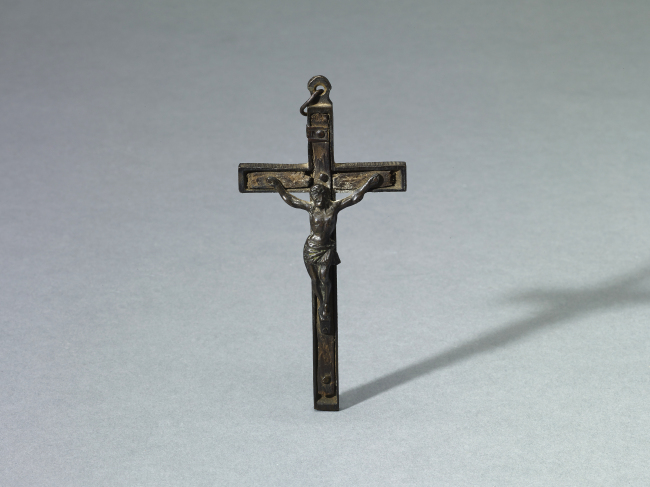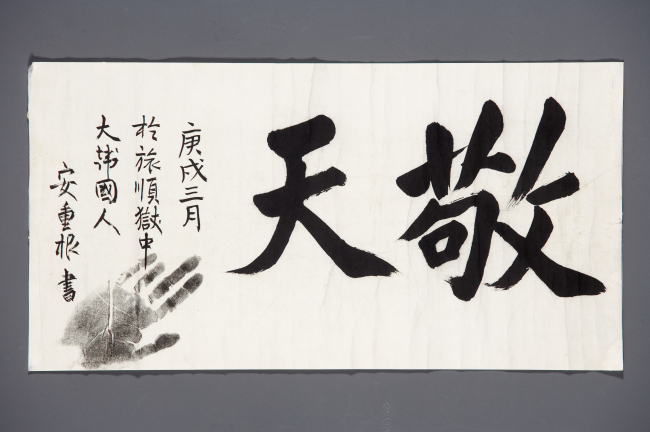From gracing TV screens and bookshelves to museums, Pope Francis is the hottest star in Korea now.
With his much-anticipated arrival here just two days away, various programs and events vie for the attention of a public curious about the leader of 1.2 billion Roman Catholics worldwide as well as the religion’s small, but strong branch here.
For Korea’s 5.4 million-strong Catholic community, which is roughly 11 percent of the population, it is a festival of faith that will culminate in the Aug. 14-18 apostolic voyage of Korea by the Holy Father.
For non-Catholics, it is a chance to get acquainted with the many aspects of the religion, which has grown from nonexistence 230 years ago to the third-largest faith in Korea, after Protestantism and Buddhism.
 |
A cross made by 18th-century scholar Jeong Yak-yong (Seoul Museum of History) |
Exhibitions
A large-scale exhibition at the Seoul Museum of History traces the roots of the Korean Catholic Church, which is characterized by its start from laity and waves of massive persecution and martyrdom.
Titled “Ode to the West and East Small Gate,” the exhibit revisits the history of the church in the 19th and 20th centuries around Seoul’s two gates, which no longer exist.
The “West Gate” section highlights the history of martyrdom. Where the gate once stood is now a public park, just north of Seoul Station, commemorating the many early Catholic believers who shed blood for their faith there.
Pope Francis will visit Seosomun (West Gate) Martyrs’ Shrine on Aug. 16 before beatifying 124 of the early martyrs at Gwanghwamun Square.
The “East Gate” section chronicles the 1909-1927 history of Baekdong Abbey, the first male abbey in Korea located in the area that is now Hyehwa-dong.
Among the items on display is a calligraphic work of independence fighter Ahn Jung-geun, who on Oct. 26, 1909, assassinated Hirobumi Ito, the first Japanese resident-general of its colony Korea.
Roughly translated to “Respect God,” it is the last such message left by Ahn, a devout Catholic, who was executed by Japan the following year.
 |
Calligraphy by Ahn Jung-geun |
The exhibition runs through Oct. 31. For more information, visit www.museum.seoul.kr.
In time for the pope’s historic visit, one of the defining masterpieces of the Italian Renaissance is coming to Korea.
The “Gates of Paradise” will go on display at the National Palace Museum in Gyeongbokgung Palace in Seoul from Aug. 15 for six months, along with some 90 sacred items ― many of them used by popes. They are on loan from Italy’s Florence Cathedral and the Vatican Museum.
Sculpted by Renaissance goldsmith, sculptor, architect and author Lorenzo Ghiberti (1378-1455), the “Gates of Paradise” are the east doors of Florence’s Baptistery of San Giovanni. Weighing 8 tons and measuring 5 meters high and 3 meters wide, the doors are famous for their 10 gilded bronze panels that depict familiar Old Testament stories. It was Michelangelo who dubbed the doors as the Gates of Paradise.
“The Gates of Paradise and many other sacred goods rarely travel abroad. Their loan to Korea was specially approved given the upcoming visit by Pope Francis,” the exhibition’s organizer said.
At Sejong Center for the Performing Arts in Gwanghwamun, a photo exhibition of Pope Francis is on show. “Hello Francisco” features some 150 photographs provided by the Vatican and photographer Paik Nam-sik who has followed pontiffs for 46 years, taking pictures of major Vatican events. It runs until Aug. 18.
Movies “The Cardinal,” a documentary on the late Cardinal Stephen Kim Sou-hwan (1922-2009), opened a week prior to the pope’s visit. The film, directed by Jeong Seong-woo, presents the life of the late clergy member, through interviews with him in his last three years and many accounts from those who knew him. As the film focus on acknowledging the cardinal as a person beyond his public image, viewers are able to draw connections between the late cardinal and the pope, both known for their humbleness, likability and compassion.
“The Letters,” a biopic of Mother Teresa’s life and legacy in Calcutta, India, will make its world premiere in Korea on Aug. 20, two weeks earlier than the opening in the United States, in celebration of the pope’s visit.
The film is based on Mother Teresa’s real letters to her spiritual mentor, Father Celeste van Exem, over a 50-year period, sharing her deepest agony of leaving her home in Albania and living among the abandoned and the dying on the streets of Calcutta. The film reveals that Mother Teresa, despite being a woman of great faith, had struggles with faith and doubts about God.
TV programs
The three major TV channels are vying for the attention of viewers with a series of special programs on Pope Francis, focusing mostly on his humble and down-to-earth lifestyle and an exceptional popularity.
Broadcaster MBC has prepared “Papa Francisco” (aired on Aug. 10) and “The Papal Way” (to air on Aug. 18) after five months of researching and filming.
SBS ran a series titled “Pope Francis: the Pope of the Streets” earlier this month, also highlighting the pontiff’s personal humility and his emphasis of “a church that is poor and is for the poor.”
The state-controlled KBS, as the official broadcaster of the papal visit, has opened a website (pope.kbs.co.kr) through which it plans to telecast news and various programs about the leader.
By Lee Sun-young and Ahn Sung-mi
(
milaya@heraldcorp.com) (sahn@heraldcorp.com)









![[Weekender] Korea's traditional sauce culture gains global recognition](http://res.heraldm.com/phpwas/restmb_idxmake.php?idx=644&simg=/content/image/2024/11/21/20241121050153_0.jpg)